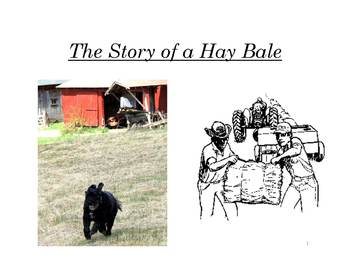2nd Grade Farm Lesson: The Story of a Hay Bale - Complete Package
Color the World
25 Followers
Grade Levels
K - 3rd, Homeschool
Subjects
Resource Type
Standards
CCSS1.G.A.1
CCSS1.G.A.2
CCSS1.G.A.3
CCSS2.G.A.1
CCSS2.G.A.2
Formats Included
- Zip
Pages
90 pages
Color the World
25 Followers
Description
Includes 42 slide presentation for classroom reading, an ebook and student worksheets. The presentation is posted for free for your preview. I am a new author so I would appreciate feedback. I will also send you the PowerPoint files if you would like to alter the lesson. Contact me at "vincent.vanhook@gmail.com".
Lesson Files
1. Teacher Lesson Plan – The Story of a Hay Bale
2. The Story of a Hay Bale choral reading – 42 slides for projection.
3. Student Worksheet – Hay Process Picture Match – 2 sheets
4. Student Worksheet - Story Work Completion and Word Search
5. Teacher - Hay Work Flow Class Card Game
6. Teacher – Word Wall Pictures for Bulletin Board
7. Student Worksheets – Hay Bale Geometry
8. Student – extra activity farm coloring sheets
9. Student Reference - Hay glossary
10. Student eBook – MacGyver the Wonder Dog: Adventure to Grandpa’s Farm
Concepts
- Plant growth requires soil, air, water and sunlight.
- Seasonal cycle of spring, summer, fall and winter.
- Farming process of plant growth, harvest and storage.
- Quadrilateral Geometry
Common Core Standards
Common Core Language Standards K–5
Listening and Speaking (2,3)
Vocabulary Acquisition and Use (4a,4e)
CCSS.MATH.CONTENT.2.G.A.1
CCSS.MATH.CONTENT.2.G.A.2
CCSS.MATH.CONTENT.2.G.A.3
Common Core Standards Massachusetts Science
Grade 2: Life Science (LS-2, PreK-LS2-3, 2-LS2-3, 2-LS4-1)
Lesson Files
1. Teacher Lesson Plan – The Story of a Hay Bale
2. The Story of a Hay Bale choral reading – 42 slides for projection.
3. Student Worksheet – Hay Process Picture Match – 2 sheets
4. Student Worksheet - Story Work Completion and Word Search
5. Teacher - Hay Work Flow Class Card Game
6. Teacher – Word Wall Pictures for Bulletin Board
7. Student Worksheets – Hay Bale Geometry
8. Student – extra activity farm coloring sheets
9. Student Reference - Hay glossary
10. Student eBook – MacGyver the Wonder Dog: Adventure to Grandpa’s Farm
Concepts
- Plant growth requires soil, air, water and sunlight.
- Seasonal cycle of spring, summer, fall and winter.
- Farming process of plant growth, harvest and storage.
- Quadrilateral Geometry
Common Core Standards
Common Core Language Standards K–5
Listening and Speaking (2,3)
Vocabulary Acquisition and Use (4a,4e)
CCSS.MATH.CONTENT.2.G.A.1
CCSS.MATH.CONTENT.2.G.A.2
CCSS.MATH.CONTENT.2.G.A.3
Common Core Standards Massachusetts Science
Grade 2: Life Science (LS-2, PreK-LS2-3, 2-LS2-3, 2-LS4-1)
Total Pages
90 pages
Answer Key
Included
Teaching Duration
3 hours
Report this resource to TPT
Reported resources will be reviewed by our team. Report this resource to let us know if this resource violates TPT’s content guidelines.
Standards
to see state-specific standards (only available in the US).
CCSS1.G.A.1
Distinguish between defining attributes (e.g., triangles are closed and three-sided) versus non-defining attributes (e.g., color, orientation, overall size); build and draw shapes to possess defining attributes.
CCSS1.G.A.2
Compose two-dimensional shapes (rectangles, squares, trapezoids, triangles, half-circles, and quarter-circles) or three-dimensional shapes (cubes, right rectangular prisms, right circular cones, and right circular cylinders) to create a composite shape, and compose new shapes from the composite shape.
CCSS1.G.A.3
Partition circles and rectangles into two and four equal shares, describe the shares using the words halves, fourths, and quarters, and use the phrases half of, fourth of, and quarter of. Describe the whole as two of, or four of the shares. Understand for these examples that decomposing into more equal shares creates smaller shares.
CCSS2.G.A.1
Recognize and draw shapes having specified attributes, such as a given number of angles or a given number of equal faces. Identify triangles, quadrilaterals, pentagons, hexagons, and cubes.
CCSS2.G.A.2
Partition a rectangle into rows and columns of same-size squares and count to find the total number of them.





